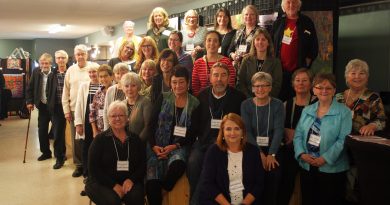March 23 COVID-19 update: New numbers, Renfew County doctor on rollout, restaurant industry moves up vaccination wait list
Special to WC Online
OTTAWA – Ottawa Public Health (OPH) is reporting another death due to COVID-19, and reports 64 new cases of the coronavirus.
The death toll related to COVID-19 has reached 457 people in Ottawa today (March 23).
The University of Ottawa Heart Institute is among the latest institutions added to OPH’s outbreak dashboard. Its witnessed three patients and two staff members contract the coronavirus since March 21. It’s the 25th healthcare institution in the city to be currently dealing with a COVID-19 outbreak.
OPH says nine schools and three childcare centres are also dealing with COVID-19 outbreaks, while there are five outbreaks in the community. The community outbreaks are linked to one multi-unit dwelling and four workplaces (one construction, one healthcare-related, one restaurant and one warehouse).
COVID-19 numbers in local hospitals remain stable, as 25 people are being treated for the virus – four of whom are in intensive care.
Indicators of COVID-19 transmission in the community remain nearly unchanged from Monday, as the weekly incidence rate is 55 per 100,000 and the positivity rate among residents being tested for the virus is still 2.9 per cent.
OPH knows of 755 active cases of COVID-19 in Ottawa.
There have been 16,252 lab-confirmed cases of the novel coronavirus in Canada’s capital since March 2020, of which 15,040 have been resolved.
The City of Ottawa has not reported another shipment of COVID-19 vaccines since March 15. At that time the city had received 97,170 doses to date. There have been 92,293 doses of COVID-19 administered in the city since December 2020. OPH typically updates local vaccine numbers on Mondays, Wednesdays and Fridays.
Renfrew acting medical officer of health frustrated with vaccination rollout delays
RENFREW COUNTY – Renfrew County’s acting medical officer of health is frustrated with the Ontario government’s rollout of the COVID-19 vaccine.
Renfrew County and District Health Unit’s (RCDHU) acting medical officer of health Dr. Robert Cushman feels there has been insufficient vaccine supply for Renfrew County, and is taking issue with Ontario rolling out its plan based on the status of the coronavirus in large urban areas, where outbreaks are high, instead of simply focusing on the province’s oldest residents in every region.
He believes Ontario is opening up the limited supply of vaccine too quickly, which could leave some seniors without access.
“We really have to concentrate on the senior citizens because otherwise we’re going to have too much queue-jumping,” Cushman said in a recent interview. “The 10,000 doses [Renfrew County expects] in the next three weeks are not going to go to the right people.”
The doctor doesn’t think the rollout is targeting those who need the COVID-19 vaccine the most.
Cushman says while a social worker in downtown Toronto dealing with homeless people is at risk, a social worker answering the phones in Renfrew County isn’t and shouldn’t be in the same priority group.
Cushman adds the province of Quebec has a much better approach in its vaccination rollout, targeting the most vulnerable seniors first.
He says, while he is 73 and a doctor, he won’t be lining up for the COVID-19 vaccine right now, since he is not a frontline healthcare worker or in the 75+ age group.
Restaurant workers join Phase 2 in vaccine rollout
ONTARIO – Ontario restaurant workers will get the COVID-19 vaccine in Phase 2, government officials said.
On March 5, Ontario officials released a list of eligible people for the COVID-19 vaccine during its next phase. This stage will see shots administered based on risk factors including age, neighbourhood, existing health conditions, and inability to work from home.
The province is planning on vaccinating nine million people in Phase 2, and the updated plan does not include the recently approved Johnson & Johnson vaccine.
After Phase 2 is completed, everyone between the ages of 16 and 59 are expected be eligible for their first dose.
The province split up workers in to different categories, including the following:
- Those who live and work in congregate settings
- All at-risk staff, essential caregivers, and residents from the following congregate settings will be eligible for the COVID-19 vaccine:
- Supportive housing
- Developmental services/intervenor and supported independent living (SIL)
- Emergency homeless shelters
- Other homeless populations not in shelters
- Mental health and addictions congregate settings
- Homes for special care Violence Against Women (VAW) shelters and Anti-Human Trafficking (AHT) residents
- Children’s residential facilities
- Youth justice facilities
- Indigenous healing and wellness
- Provincial and demonstration schools
- Farmworkers who live in congregate settings, including temporary foreign workers, bail beds and Indigenous bail beds
- Adult correctional facilities
- Essential workers/those who can’t work from home
Workers who can’t work from home will be vaccinated in two groups encompassing a variety of sectors. The second group will be eligible once the first group has been vaccinated.
The first group of essential workers (730,000 people):
- Elementary/secondary school staff and bus drivers that transport students
- Workers responding to critical events (e.g., police, fire, compliance, funeral, special constables)
- Child care workers
- Licensed foster care workers
- Food manufacturing workers
- Agriculture and farm workers
- Remaining workers to be eligible (1.4 million people)
- High-risk and critical retail workers (grocery and pharmacies)
- Remaining manufacturing workers
- Social workers (including youth justice)
- Courts and justice system workers (including probation and parole)
- Lower-risk retail workers (wholesalers, general goods)
- Transportation, warehousing, and distribution
- Energy, telecom (data and voice), water and wastewater management
- Financial services
- Waste management
- Mining, oil, and gas workers
As part of Phase 2 of the rollout, the province will see vaccine shipments ramp up throughout March with the most significant coming from Moderna.
Though non-committal on the matter, Retired Gen. Rick Hillier said mass-vaccinations could begin on June 20, depending entirely on vaccine supply in the coming months.
“Our aim to be is to allow the province of Ontario to have a first needle in the arm of every eligible person who wants it by the first day of summer,” Hillier said. “That’s the challenge goal I put out there. Twenty of June, coming up.”











